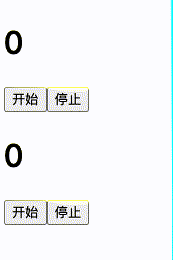useRef
基本用法
提起 useRef,很多人都会把它跟 DOM 联系起来。其实 useRef 不止可以用来存储 DOM 元素。它的定义是:
如果希望组件记住某些信息,但又不想让这些信息触发新的渲染,可以使用 useRef。
比如下面这个例子:
import React, { useState, useEffect } from 'react';
let timer = null;
function Counter() {
const [count, setCount] = useState(0);
const onStart = () => {
timer = setInterval(() => {
setCount((count) => count + 1);
}, 1000);
};
const onStop = () => {
clearInterval(timer);
};
useEffect(() => {
return () => {
clearInterval(timer);
};
}, []);
return (
<>
<h1>{count}</h1>
<button onClick={onStart}>开始</button>
<button onClick={onStop}>停止</button>
</>
);
}
这个例子里,我们写了一个 Counter 组件。点击开始按钮 count 每秒增加 1,点击停止按钮 count 停止增加。
看上去,这个组件好像很 OK。
但是如果在一个页面使用 Counter 组件两次,就会发现,第一个定时器停止不了。
export default function App() {
return (
<div className='App'>
<Counter />
<Counter />
</div>
);
}
如下图:

这是因为两个组件公用同一个 timer 变量,第二个组件修改 timer 后,导致第一个组件中 clearInterval 处理的是第二个组件的 timer。 因此第一个组件无法停止定时增加。
官网推荐我们使用纯函数编写组件也是基于此。
估计有人会说,我可以把 timer 变量放到 Counter 内部。组件内部的变量是互相隔离的, 这样就不会把第一个 Counter 组件的 timer 给覆盖了。
放到内部有两种情况:
1. 直接使用变量。 当组件更新的时候,组件函数重新执行,会导致 timer 重新创建,因此并不能清除之前的 timer。
2. 使用 state。 使用 state 可以解决问题,但是会导致不必要的渲染。每次 timer 变化都会导致组件重新渲染。
其实对于这种定时器清理的问题,我们可以使用 useRef。useRef 创建一个变量,变量里有一个 current 属性。
const timeRef = useRef(null);
比如上面这段代码,会创建一个变量 timeRef, 它的结构类似 { current: null }。
使用 ref 修改上述例子中的代码:
function Counter() {
const [count, setCount] = useState(0);
const timeRef = useRef(null);
const onStart = () => {
timeRef.current = setInterval(() => {
setCount((count) => count + 1);
}, 1000);
};
const onStop = () => {
clearInterval(timeRef.current);
};
useEffect(() => {
return () => {
clearInterval(timeRef.current);
};
}, []);
return (
<>
<h1>{count}</h1>
<button onClick={onStart}>开始</button>
<button onClick={onStop}>停止</button>
</>
);
}
运行试试,完美解决了之前的问题。
可以这样理解,ref 跟 state 的区别是,ref 不会导致组件重新渲染。
使用 ref 操作 DOM
我们来看一个 ref 操作 DOM 的例子:
import { useRef } from 'react';
export default function Form() {
const inputRef = useRef(null);
function handleClick() {
inputRef.current.focus();
}
return (
<>
<input ref={inputRef} />
<button onClick={handleClick}>聚焦输入框</button>
</>
);
}
效果:点击聚焦输入框按钮,输入框将会聚焦。

这段代码主要做了以下事情:
- 使用
useRefHook 声明inputRef。 <input ref={inputRef}>告诉 React 将这个 input 的 DOM 节点放入inputRef.current。- 在
handleClick函数中,从inputRef.current读取 input DOM 节点并调用它的focus()。 - 给按钮添加点击事件
handleClick
forwardRef
我们可以使用 ref 属性配合 useRef 直接调用 DOM。那么可不可以给组件添加 ref 调用组件的 DOM 呢?让我们来试一下:
import { useRef } from 'react';
function MyInput(props) {
return <input {...props} />;
}
export default function MyForm() {
const inputRef = useRef(null);
function handleClick() {
inputRef.current.focus();
}
return (
<>
<MyInput ref={inputRef} />
<button onClick={handleClick}>聚焦输入框</button>
</>
);
}
我们给 MyInput 组件加上了 ref,可是当我们点击 聚焦输入框按钮,则会报错:Cannot read properties of null (reading 'focus')
也就是说 inputRef.current 是 null。我们并不能拿到组件的 DOM 元素。
默认情况下,React 不允许组件访问其他组件的 DOM 节点。这是因为 ref 是应急方案,应当谨慎使用。如果组件想要暴露自己的的 DOM,则需要使用forwardRef来包装,并把 ref 转发给自己的子元素。 比如这样:
import { forwardRef, useRef } from 'react';
const MyInput = forwardRef((props, ref) => {
return <input {...props} ref={ref} />;
});
export default function Form() {
const inputRef = useRef(null);
function handleClick() {
inputRef.current.focus();
}
return (
<>
<MyInput ref={inputRef} />
<button onClick={handleClick}>聚焦输入框</button>
</>
);
}
它是这样工作的:
<MyInput ref={inputRef} />告诉 React 将对应的 DOM 节点放入inputRef.current中。但是,这取决于MyInput组件是否允许这种行为, 默认情况下是不允许的。MyInput组件是使用 forwardRef 声明的。 这让从上面接收的inputRef作为第二个参数 ref 传入组件,第一个参数是 props 。MyInput组件将自己接收到的 ref 传递给它内部的<input>。
这样就通过 forwardRef 向父组件暴露了子组件的 DOM 节点。
